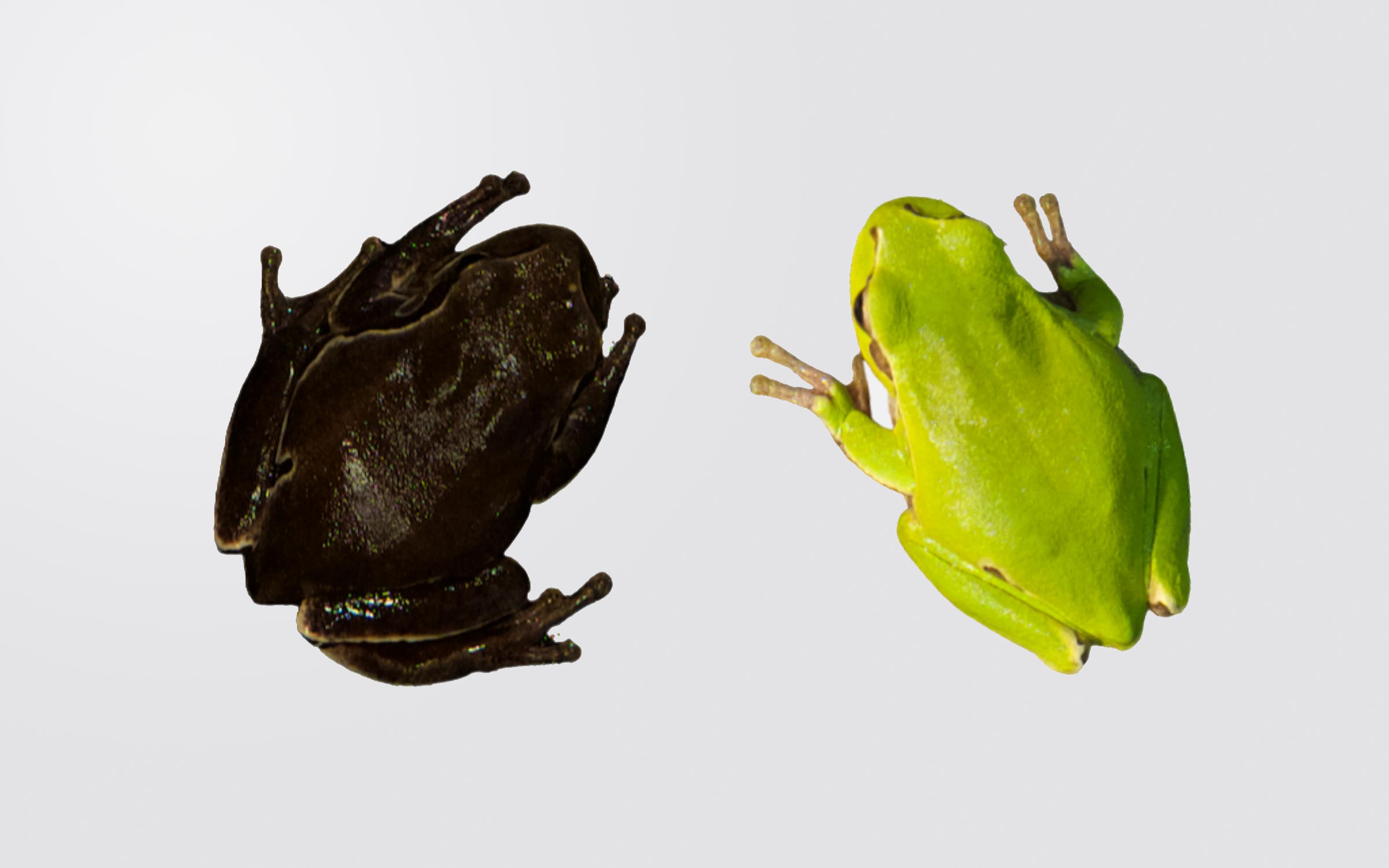Extreme gradient of the eastern San Antonio frog (Hyla orientalis). On the left a specimen caught in Chernobyl in the high contamination zone; on the right a specimen caught outside the restricted zone. Credit: Germán Orizaola/Pablo Burraco, CC BY
The largest release of radioactive material into the environment in human history occurred in 1986 with an accident on April 26 in reactor four of the Chernobyl nuclear power plant. Severe impacts on the environment and human population resulted from acute exposure to high doses of radiation. But more than three decades after the accident, Chernobyl has become one of the largest nature reserves in Europe. Today, a large number of endangered species find refuge there, including bears, wolves and lynxes.
The Chernobyl disaster is one of only two nuclear accidents rated seven – the maximum severity – on the International Nuclear Event Scale, the other being the 2011 Fukushima nuclear disaster in Japan.

View of reactor 4 of the Chernobyl nuclear power plant from Lake Azbuchyn (Ukraine), 2019. Photo: Germán Orizaola
Radiation can damage the genetic material of living organisms and cause unwanted mutations. However, one of the most interesting research topics at Chernobyl is trying to find out if some species are actually adapting to life with radiation. As with other pollutants, radiation could be a very powerful selection factor, favoring organisms with mechanisms that increase their survival in radioactive-contaminated areas.
Ironically, the Chernobyl accident happened during a safety test. The resulting meltdown and explosions ruptured the reactor core and destroyed the reactor building. This was immediately followed by an outdoor reactor core fire that lasted until May 4, 1986.

Contaminated area within Chernobyl Exclusion Zone (Ukraine). Photo credit: ArcticCynda
Melanin protection from radiation
Our work in Chernobyl started in 2016. In that year we discovered several Eastern Tree Frogs (Hyla orientalis) with an unusual black tint. The species usually has a light green back colouration, although darker individuals can occasionally be found.
Melanin is responsible for the dark color of many organisms. What is less well known is that this class of pigments can also reduce the negative effects of ultraviolet radiation. And its protective role can also extend to ionizing radiation, as has been shown in fungi. Melanin absorbs and disperses part of the radiant energy. In addition, it can ionized molecules inside the cell, such as. B. reactive oxygen species intercept and neutralize. These measures make people exposed to radiation less likely to suffer cell damage and increase their chances of survival.

Male St. Anthony’s frog (Hyla orientalis) at a site outside the Chernobyl Exclusion Zone (Ukraine), 2019. Photo credit: Germán Orizaola
The color of the Chernobyl tree frogs
After discovering the first black frogs in 2016, we decided to investigate the role of melanin coloration in Chernobyl wildlife. Between 2017 and 2019, we studied in detail the coloration of eastern tree frogs in different areas of northern Ukraine.
During these three years we analyzed the dorsal skin coloration of more than 200 male frogs collected from 12 different breeding ponds. These sites were distributed along a broad gradient of radioactive contamination. They included some of the most radioactive areas on the planet, but also four sites outside the Chernobyl Exclusion Zone and with background radiation levels used as controls.
Our work shows that Chernobyl tree frogs are much darker in coloration than frogs caught in out-of-zone control areas. As we found out in 2016, some are pitch black. This coloring has nothing to do with the radiation that frogs are exposed to today and that we can measure in all individuals. The dark coloration is typical of frogs from or near the most contaminated areas at the time of the accident.

Gradient of the Eastern Antonius Frog (Hyla orientalis) in northern Ukraine. Credit: Germán Orizaola/Pablo Burraco, CC BY-SA
Evolutionary reactions in Chernobyl
The results of our study suggest that Chernobyl frogs may have undergone a process of rapid evolution in response to radiation. In this scenario, the darker colored frogs, which normally represent a minority in their populations at the time of the accident, would have benefited from the protective effect of melanin.
The dark frogs would have survived the irradiation better and reproduced more successfully. More than ten generations of frogs have passed since the accident, and a classic, albeit very rapid, process of natural selection could explain why these dark-colored frogs are now the dominant species for the species within the Chernobyl Exclusion Zone.

Lake Glyboke, Chernobyl Exclusion Zone (Ukraine), 2019. Photo credit: Germán Orizaola
Studying the Chernobyl black frogs is a first step towards better understanding the protective role of melanin in environments affected by radioactive contamination. In addition, it opens the doors to promising applications in fields as diverse as nuclear waste management and space exploration.
We hope that the current war in Ukraine will end soon and that the international scientific community can again study the fascinating evolutionary and rewilding processes of the Chernobyl ecosystems together with our Ukrainian colleagues.
Written by:
- Germán Orizaola – Investigador Ramón y Cajal, Universidad de Oviedo
- Pablo Burraco – Postdoctoral Fellow at the Juan de la Cierva Incorporación, Estación Biológica de Doñana (EBD-CSIC)
This article was first published in The Conversation.![]()
#Protection #Melanin #Black #Frogs #Chernobyl #Reveal #Evolution #Action


Leave a Comment